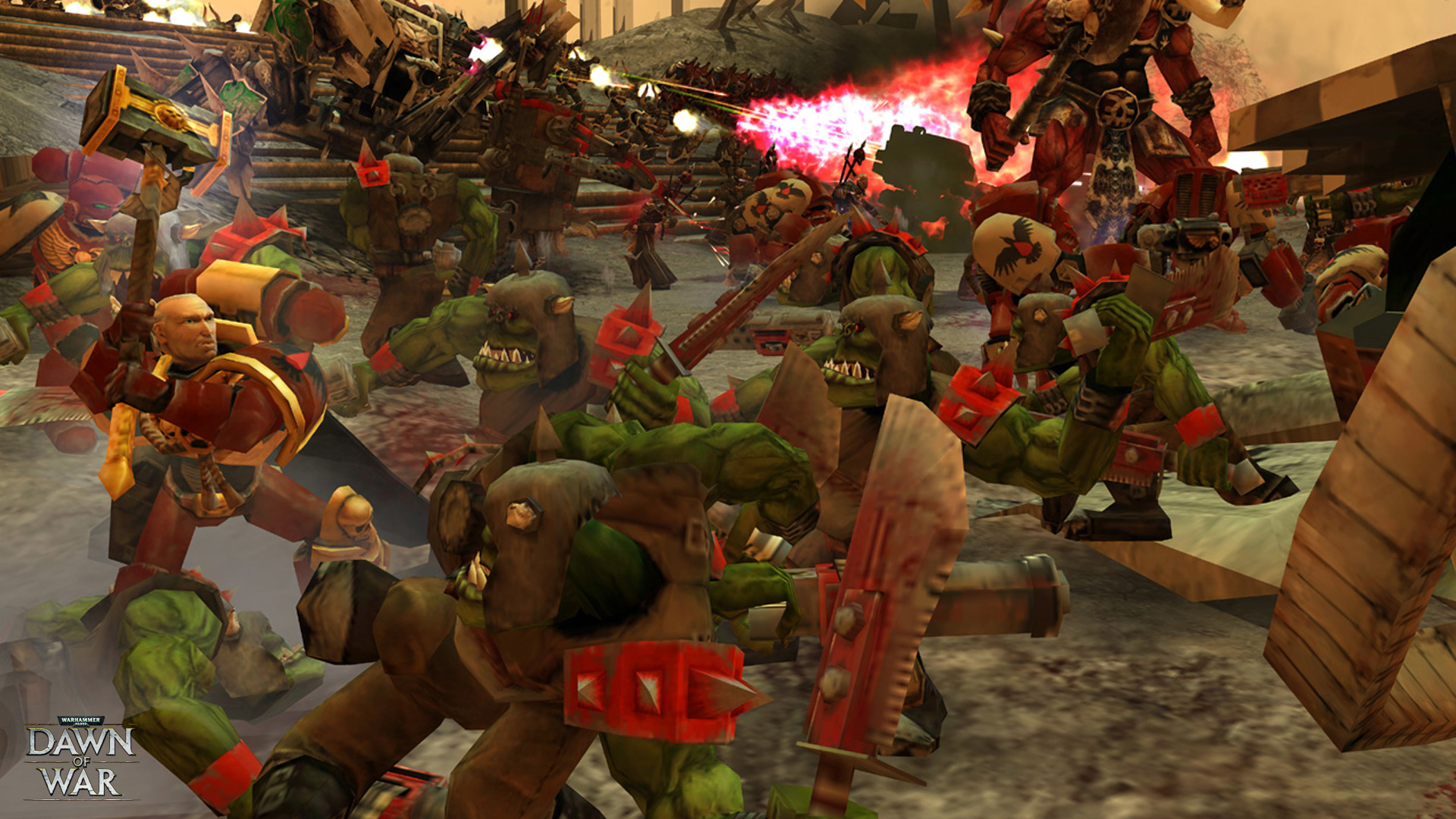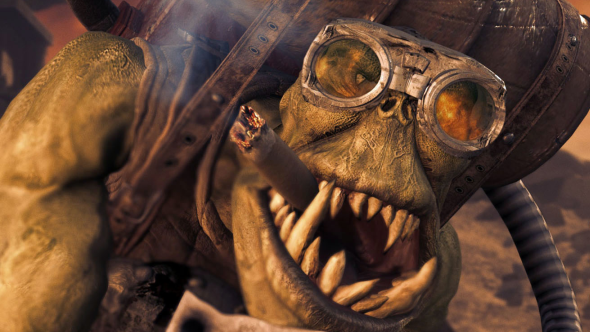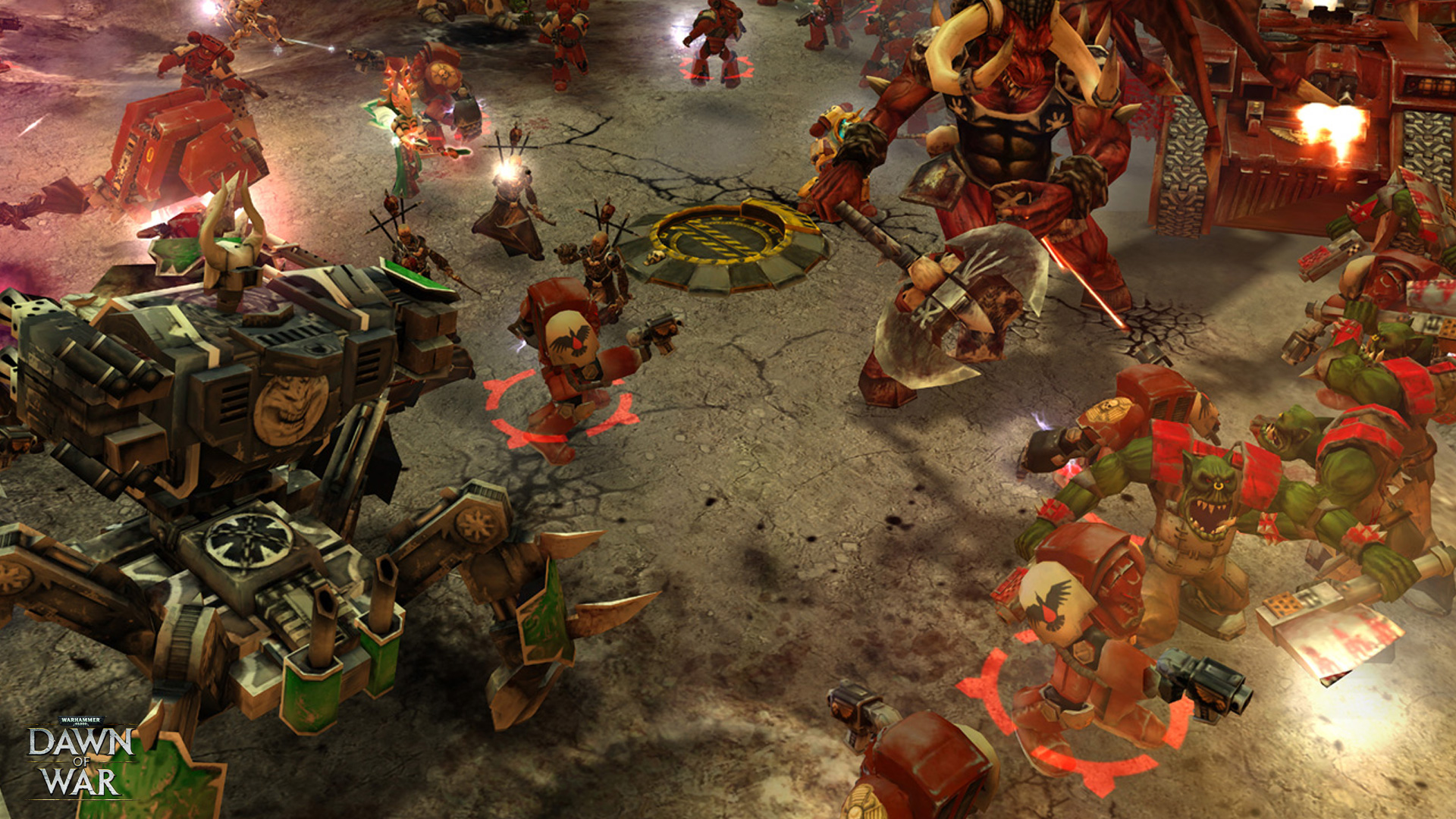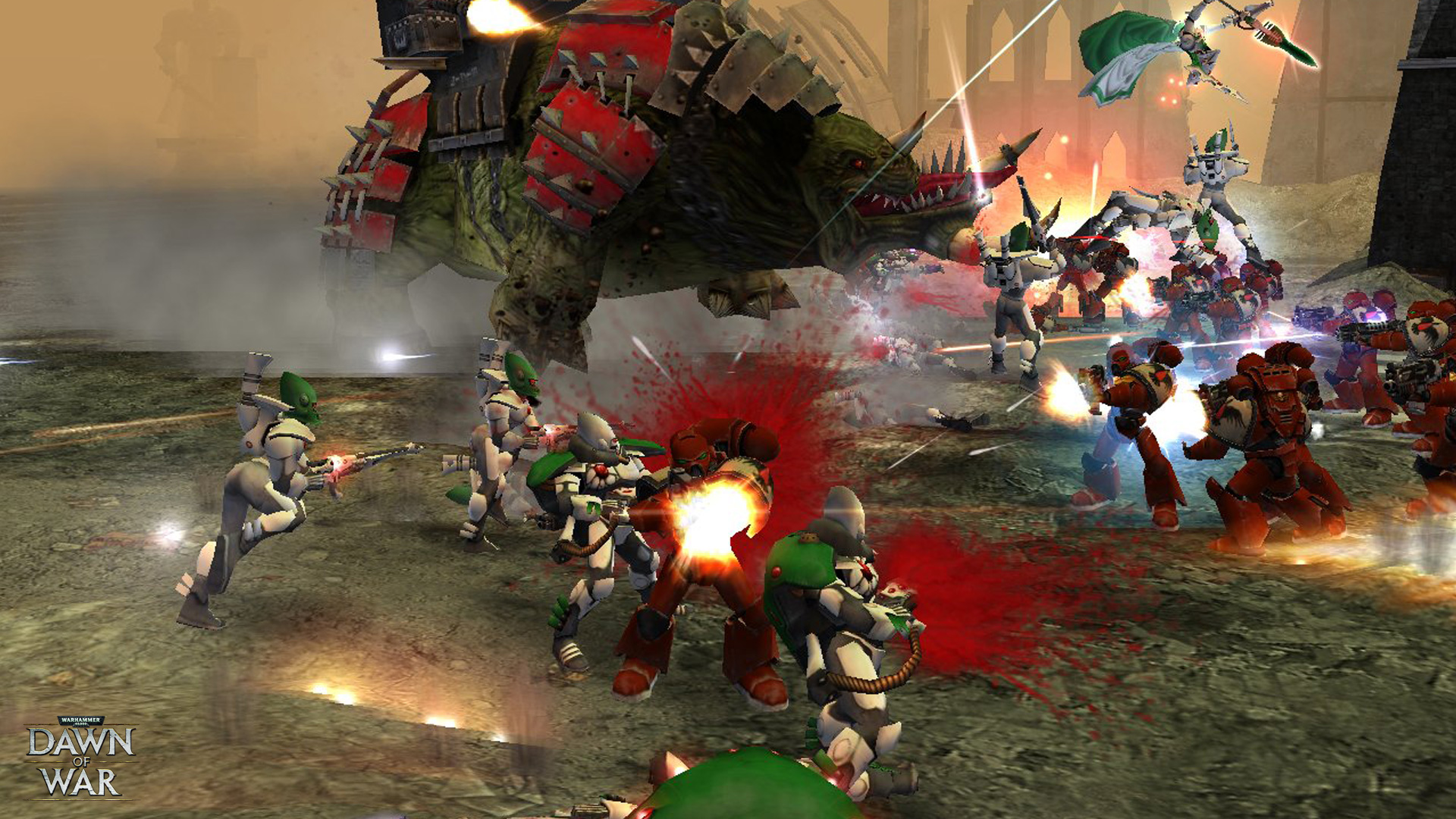This is where it all began: the original Dawn of War. Okay, technically it began with Warhammer 40K: Fire Warrior, but Fire Warrior, a first-person shooter where you played as a T’au commando, was a weird game whose reach exceeded its grasp in some ways while being fundamentally unambitious in others. We’ll probably take a look at it later — much, much later, as much later as I can possibly contrive — but the resurgence of Warhammer 40K as a video game license began with Dawn of War, which was released roughly a year later, in 2004.
Let’s get this out of the way first: Dawn of War is a tough game to play in 2019 unless you’re willing to mod it. Even the Game of the Year edition does not allow you rebind the keyboard controls at all, so you’re going to have to play southpaw, since camera movement is on the arrow keys instead of WASD and all your other shortcuts, like Attack Move or stance changes, are on your resting left hand side of the keyboard. You can’t zoom out as far as you’d like because this was made in 2004, when it was a legitimate concern to have even an eighth of a standard RTS map on the screen at once and they obviously didn’t want to have to render too much beyond the map edge. You’re also missing some quality of life improvements that would come later in the RTS genre, such as the ability to destroy your own structures or troops with a button press or, failing that, even attack them directly with an explicit attack command. This might not sound like much, but if you’re foolish enough to accidentally wall yourself in with turrets to the extent that vehicles can’t get past, you’ll have to spawn some Whirlwind artillery vehicles and hope they’re able to take out the offending buildings with their Attack Ground command, or you’ll have to restart. Those are your two options.

It’s incredible how far pathing algorithms have come since Dawn of War as well; they made an explicit choice in having your vehicles be chunky and take up a lot of space, giving them real weight — even the Eldar’s floating gun platforms feel this way — but you’ll run into a lot of problems with your infantry trying to get past your vehicles if you’re running a mixed command group, and when your troops do arrive in an area, if they’ve been told to group move, it seems like each unit is programmed to arrive a certain distance away from the waypoint and from other units, to create a formation. The problem arises if (and realistically, when) your units can’t arrive at that point because the terrain doesn’t exist for it, in which case they might very well wander off into a nearby enemy base and get themselves killed or ruin the ambush you were planning.
All of this is to say that RTS fans from the turn of the century will recognize this as one of those RTS games, where micro became incredibly important to competitive play and the limitations of the game’s pathing and attacking AI in turn developed more skilled metagames. Still, this is no Starcraft or Starcraft: Brood War; there was never a huge competitive scene for this game despite its wild popularity as a single-player concern and extreme playability in multiplayer. Dawn of War was in some respects far ahead of its time: all gameplay is based around taking and holding key locations on a map, with hero units supplementing basic units to add special abilities and greater survivability to your armies. If this sounds roughly like an early MOBA, well, there’s a reason for that: it was one of the first RTS games whose development cycle happened after the release of Warcraft III and, perhaps more importantly, the incredibly popular Defense of the Ancients mod for that game, both of which were released in 2002. While the concept of having hero units and normal RTS units coexisting as a normal part of gameplay was pioneered by the base Warcraft III game, the idea of normal gameplay focusing its resource layer on locating and contesting key nodes on the map with your armies rather than creating new bases at expansion points was very reminiscent of DOTA — in that mod, your hero would gain gold and experience from taking the tower positions, because that was where the most lucrative enemies were; in Dawn of War, you had to take “requisition points” with your armies because they literally provided you the resource that you used to play the game.

The idea of requisition as a universal generic resource that cuts across all factions and races comes from the Warhammer 40K tabletop game, and is one of the best ideas Dawn of War brings to the table: one resource to manage which every faction engages with and requires aggressive action on the battlefield to acquire. Having one resource instead of the two that Blizzard’s RTS games usually went with — minerals and gas in Starcraft; gold and wood in Warcraft (with occasional boutique tertiary resources like oil, but those always felt like design missteps) — lowered complexity, and therefore theoretically lowered the ceiling of high level play, but what was given up in that balancing act was paid back by putting all resource points in the direct lanes of battle, rather than in cul-de-sacs filled with the resource as multiplayer Starcraft and Warcraft II and Warcraft III maps were wont to do. This basic back and forth — where to earn your building resource you needed to remain in the natural path of battle, with little to no ability to chokepoint off high-value requisition nodes given the limited build range a claimed node would give you — was the centerpiece of gameplay, and it worked well enough to get three expansions and a sequel built on a very similar ruleset, that itself received two further expansions.
The game’s multiplayer is fairly close to dead at this point — there were all of four players logged in when I visited one Friday night — but the service is still there and functional if you’d like it. Most Dawn of War play in 2019, however, will be done either in the game’s skirmish mode against the AI, or in the campaign. And the Dawn of War campaign is a real treat.
It’s eleven missions long, which is a strange number, and you’re only permitted to play as the Space Marines, who are represented in this game and the entire Dawn of War franchise by the Blood Ravens. The Dawn of War series of games have been very good to the Blood Ravens; as someone who had very little exposure to Warhammer 40K before and after my time with these games, I assumed they were the primary protagonist faction in Space Marine lore, not the Ultramarines. The campaign concerns the fate of the planet Tartarus, and the efforts of a Blood Ravens force under the direction of then-Commander Gabriel Angelos to save it from what appears at first to be an Ork infestation. Anyone who has read a 40K story will know that the truth is far more complicated and sinister, and revolves around a Chaos sorcerer trying to reawaken an ancient daemon of Khorne while an Eldar Farseer tries desperately to stop him.

As far as gameplay goes, there are none of the special win condition missions you’d expect in a Blizzard RTS campaign; even on missions where you start out with limited forces, you quickly get the building units and resources to begin assembling an army the same way you would in any skirmish or multiplayer game. If the campaign’s design overindulges in anything, it’s map size and mission length; later missions can take from forty minutes up to an hour even though victory was assured around the twenty minute mark, because you still need to defeat all enemies on the map and if you outpace your expansion via requisition nodes with an unbeatable army, the AI will just send units into your backlines to wreak havoc. In order to get through the later missions in any reasonable amount of time, you have to train yourself to think that a Chaos Predator tank in your back ranks is fine, even if it will take out three requisition nodes; your main strike force has more pressing engagements at the Chaos base.
One thing about which the campaign is emphatic is that the Eldar are fundamentally correct in all their assessments and actions. At their best, the Blood Ravens are both too proud and too suspicious to heed the Eldar’s warnings or entertain their attempts at counsel; at their worst, they’re actively genocidal racists. That dynamic is hardly unique to these Space Marines or this game, and a lot has happened in the 40K metaplot since 2004 for both the Imperium of Man and the now-Aeldari to make that relationship more complicated, but while the final mission of the Dawn of War campaign technically has the Eldar force on Tartarus present as your allies, they’re intentionally gimped, basically useless, and don’t complement your forces or your development at all — they basically rush the Chaos base, get fucked up, and then get destroyed by the Chaos counterattack unless you deign to save them — and the final cutscene of the game begins with Angelos destroying the stone containing the daemon in question while the Farseer yells at him to stop. He’s rewarded for this act of oppositional defiance with an extended monologue from the now-freed daemon of Khorne about how thoroughly he and the Blood Ravens assisted in the daemon’s release. Angelos is permitted to end the scene with a sneering bit about how this is good because now the daemon can be killed by the Emperor’s finest, but frankly, the Tartarus campaign is a disaster: the Marines lose the planet, lose almost all of the planet’s population by refusing to protect the evacuation, lose a Librarian to Chaos, and free a powerful Chaos daemon.
There’s a danger in making the Eldar so clearly in the right and protagonist Space Marines so clearly unwilling to listen to them; Angelos ends the campaign looking like a fool, rather than a man betrayed by his circumstances. And as far as it goes, it’s fine for guys like Angelos to look like fools from time to time…but this isn’t the last time in this series that the Imperium and Eldar will come to blows because the Eldar prioritized being condescending over the thing they actually wanted to talk about and the Space Marines cut them off and open fire. Eventually that sort of writing comes off less descriptive of two cultures fundamentally unable to work together, and more just contrived.

That said, it’s hard to argue the Dawn of War campaign doesn’t hit all the setting high-notes with the four factions it represents, and you even get a little bit of Imperial Guard in there in the later missions. The experience is anchored by a voice actor roster that ranges from very good to standout, with Paul Dobson (Gabriel Angelos) and Scott McNeil (Sindri Myr, the Chaos sorcerer) being the greatest individual performances. Dobson sells Angelos’s devotion to his order and the Emperor as well as his inner conflict about his past and his mission without leaving the broad, stern, bombastic campy affect one expects from a larger-than-life Space Marine captain; McNeil’s Sindri Myr is half Jafar from Disney’s Aladdin and half daemonic temptor, switching from sickly-sweet condescension to the wild core of rage hiding just underneath and back again with ease. There’s a craft here to the genre camp that clearly sets this roster of voice actors apart from the ones brought in for Warhammer 40K: Inquisitor – Martyr, though in fairness to the latter group, they were handed a script with far less to work with than their Dawn of War counterparts. The campaign script is basic, surely, but it’s also fully competent and doesn’t try to play comedy.
Final Verdict: A foundational title and one you probably already own if you’re reading this website. If you don’t, it’s likely because you bought a physical copy (yeah, 2004) and can’t find it anymore. So long as you’re willing to live with the left-hand mouse, it’s very much worth paying the $13 on Steam it’ll take to get this back in your collection.
Next week, we’ll look at the three Dawn of War expansions, Winter Assault, Dark Crusade, and Soulstorm.


